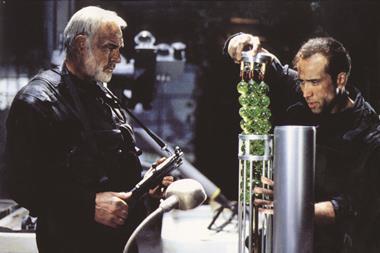Tests confirm sarin was used in the conflict, questions remain regarding how stockpiles will be destroyed.
Experts have welcomed the Syrian government’s pledge to sign up to the Chemical Weapons Convention, which outlaws the production and use of chemical weapons and commits signatories to destroying stockpiles. But the challenge of decommissioning existing chemical weapons before mid-2014, as agreed in the framework document, is thought to be highly optimistic given previous experience of putting such materials beyond use.
Syria’s move to join the convention was followed by the announcement by a UN inspection team that the nerve agent sarin, a fluorinated organophosphate, was used in the Ghouta area of Damascus on 21 August this year. The Syrian government denies that it was responsible for the attack. Figures for casualties remain sketchy, but the charity Médecins Sans Frontières says that three hospitals that it supports in Damascus treated 3600 people with neurotoxic symptoms, of whom 355 died.
Signs of sarin
The UN inspection team describe in their report how they found ‘clear and convincing evidence that surface-to-surface rockets containing the nerve agent sarin were used.’ The team collected samples including soil, fabric and rocket fragments as well as urine, hair and blood from survivors, which were sent for analysis at laboratories designated by the Organisation for the Prevention of Chemical Weapons in Finland, Germany, Sweden and Switzerland. The tests, including gas chromatography-mass spectrometry and liquid chromatography-mass spectrometry, revealed the presence of sarin itself in many of the samples, together with isopropylmethyl phosphonate, a primary degradation product of sarin, and other thermal decomposition products.
Destroying chemical weapons is an extremely complicated, lengthy and expensive process
Syria’s agreement to join the Chemical Weapons Convention is significant, according to Oliver Meier, a chemical weapons expert at the German Institute for International and Security Affairs. ‘The fact that they have agreed to sign up is a big step forward, as they are not only committed to providing information about weapons stocks and production facilities, but they are bound to allow challenge inspections if another member state suspects use or production of such weapons,’ he says.
But the logistics of decommissioning weapons remains a serious challenge says Meier. ‘We know from previous experience that destroying chemical weapons is an extremely complicated, lengthy and expensive process and technologically demanding. It is not a job that can be done quickly and it has taken several years and in some cases more than a decade to destroy stocks in circumstances much better than they are currently in Syria.’
According to a report prepared for the US Congress in September, Syria not only possesses stockpiles of sarin but also the nerve agent VX, and mustard gas. It is estimated that Syria has around 1000 tonnes of these chemicals. Two main options for destruction exist, incineration or hydrolysis, sometimes termed neutralisation.
Difficult decisions
Paul Walker is an expert on chemical weapons at the environmental organisation Green Cross International. ‘Neutralisation processes are generally favoured by the public health and environmental communities because it is a ‘batch, test, and release’ process which can contain all toxic effluents and measure the toxicity of the liquid, gaseous, and solid waste before sending it for secondary processing or releasing it into the environment,’ he says. ‘Incineration, which has operated very well in the US as a first-stage process, releases most of its waste in gaseous form up the smokestack with very little knowledge whether it contains persistent organic pollutants or other pollution.’
Whether destruction would be carried out close to the storage repository or transported to some central facility remains to be decided. ‘One needs a dedicated facility designed to fully destroy the precursor chemicals, agents, and weapons, including explosives and rocket propellant, and one which can decontaminate all metal parts,’ Walker says. ‘This could be an incinerator, a bioremediation plant, or an explosive detonation system, likely all three, which can also contain and control all toxic emissions in order to protect public health and the environment.’
Ideally, destruction is carried out close to the storage point to avoid risks associated with transportation. ‘In Syria, precursor chemicals – dual-use industrial chemicals – could be transported for destruction, but live agents and weaponised agents should be destroyed close to their stockpiles,’ says Walker. ‘I would assume this would also help improve security and safety challenges, and hopefully no more than a few sites would be needed.’
One possible solution could be the use of a new portable destruction facility developed by the US Department of Defense. The Field Deployable Hydrolysis System (FDHS) can, according to its developers at the Edgewood Chemical Biological Center in Maryland, be deployed within ten days of arriving at its location and its titanium reactor can process between five and 25 tonnes of material a day, depending on the substances being treated. Sodium hydroxide and sodium hypochlorite are the reagents used for the neutralisation, producing effluent that can be treated as hazardous commercial waste under prevailing environmental legislation.
As Walker comments, however, ‘It will be difficult to predict the best destruction options for Syria until more specific details of its programme are known: how many sites, how many weapons, what types of agents, the amount of precursor chemicals, and the condition of the stockpiles.’
Walker adds, ‘the good news is that the governmental and private sectors of the United States, Russia, Germany, Japan and other countries have many years of experience that can help guide the project. The bad news? It will be a long-term, expensive operation.’












No comments yet